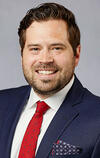In The News: Center for Business and Economic Research
From the valets parking cars to the dealers at the blackjack tables to the bartenders at the city's many bars, Las Vegas relies on people working for tips.

From the valets parking cars to the dealers at the blackjack tables to the bartenders at the city’s many bars, Las Vegas relies on people working for tips. “Las Vegas was built on tips,” said James Reza, a city native who owns two high-end beauty salons in town.

From the valets parking cars to the dealers at the blackjack tables to the bartenders at the city’s many bars, Las Vegas relies on people working for tips. “Las Vegas was built on tips,” said James Reza, a city native who owns two high-end beauty salons in town.

Tourism and gaming are the largest economic powerhouses in Las Vegas, bringing in the most money for the regional economy. According to data from the American Gaming Association, the casinos industry’s economic impact in Nevada in 2023 totaled $59.4 billion, and the industry was responsible for supporting more than 330,000 jobs. These figures highlight how important tourism is to the Las Vegas economy. Even though this sounds good in hindsight, the overdependence on tourism creates a challenge for the overall health of the Southern Nevada economy when gaming revenues falter.

Recession fears are mounting in the United States after a weak jobs report triggered a stock market plunge not seen in years, but local economic analysts say Las Vegas residents shouldn't sound the alarm just yet.

Recession fears are on the rise in the U.S. on the heels of a weak jobs report that kicked off a stock market drop not seen in years, but local economic analysts say Las Vegas residents shouldn’t be ringing any alarm bells just yet.

Athena Young has spent more than a decade developing her skills as a server. She knows how good she is now – because of the tips she receives while working at The Kitchen at Atomic. If those tips weren’t taxed, she said, she’d be better able to support herself and her child.

Athena Young has spent more than a decade developing her skills as a server. She knows how good she is now – because of the tips she receives while working at The Kitchen at Atomic. If those tips weren’t taxed, she said, she’d be better able to support herself and her child.

Clark County should be preparing for declining birth rates and decreased immigration now, as the nation’s population is expected to peak in less than 60 years.

Back in 1996, the UNLV’s Center for Business and Economic development projected that Clark County would have 2.26 million residents by 2024. Turns out they weren’t far off as this year the same report, the 2024-2060 Population Forecasts has the county’s population at 2.41 million, so 26 years ago they were only off by approximately 147,000 residents.

UNLV has released projections for Clark County's population covering the next 35 years. The university's Center for Business and Economic Research (CBER) on Wednesday published its 2024-2060 population forecasts.

Clark County is expected to hit 3 million residents in 2042, according to a new UNLV report. The county’s population is expected to grow “steadily” in the near future, adding approximately 38,414 residents to its population in 2024 and continue growing at more than 1 percent per year up until 2039 when it will have 2.9 million residents, said Andrew Woods, director of the Center for Business and Economic Research at UNLV.


